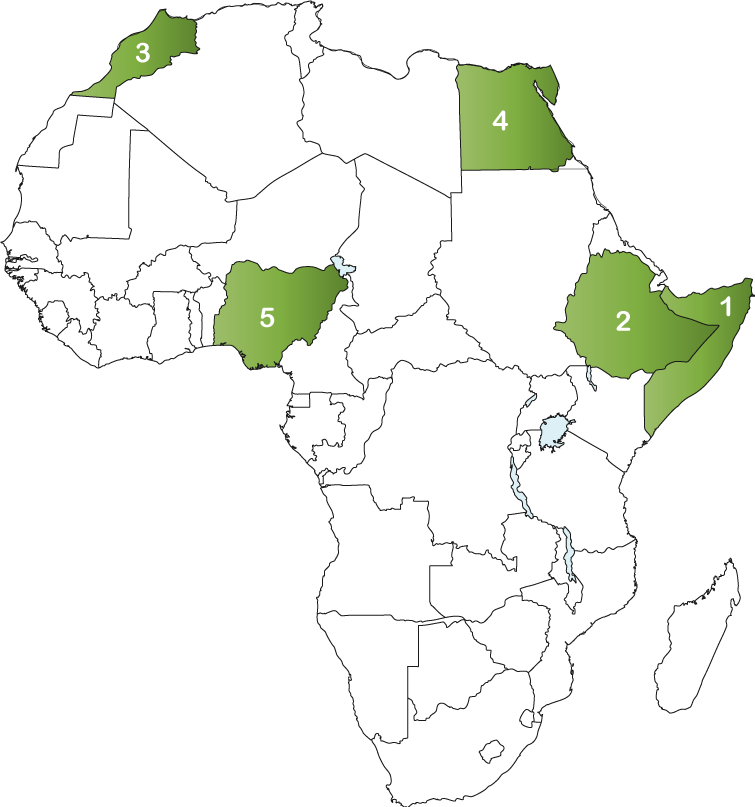
- 0
- 1
- 2
- 3
- 4
- 5
- 6
- 7
- 8
- 9
- ,
- 0
- 1
- 2
- 3
- 4
- 5
- 6
- 7
- 8
- 9
- 0
- 0
- ,
- 0
- 0
- 0
Although Sweden has made strides in reaching the 90-90-90 target set by UNAIDS, there is a HIV epidemic among migrants. Eighty percent of those diagnosed with HIV in Sweden are migrants (defined as originating outside the country in which they are diagnosed). There is evidence to suggest that a substantially higher proportion of migrants are infected with HIV after their arrival in Sweden than what has been estimated using routine clinical reports. Another complicating factor in uncovering how HIV affects key populations in Sweden is that AIDS reporting has not been mandatory in Sweden since 2000. AIDS data is not available from 2008-2016 because the national AIDS surveillance system had been discontinued.
-MIGRANT POPULATIONS
MIGRANT POPULATIONS
AND HIV
- 0
- 1
- .
- 0
- 1
- 2
- 3
- 4
- 5
- 6
- M
- i
- l
- l
- i
- o
- n
- U
- n
- k
- n
- o
- w
- n
- U
- n
- k
- n
- o
- w
- n
- U
- n
- k
- n
- o
- w
- n
TOP 5 AFRICAN COUNTRIES
OF ORIGIN FOR MIGRANTS IN SWEDEN
- 1. Somalia: 59,213
- 2. Ethiopia: 16,509
- 3. Morocco: 9.233
- 4. Egypt: 5,934
- 5. Nigeria: 4,455
-TOTAL POPULATION
PEOPLE LIVING WITH HIV
- 0
- 1
- 2
- 3
- 4
- 5
- 6
- ,
- 0
- 1
- 2
- 3
- 4
- 5
- 6
- 7
- 8
- 9
- 0
- 1
- 2
- 3
- 4
- 0
- 1
- 2
- 3
- 4
- 5
- 6
NEW INFECTIONS
- 0
- 1
- 2
- 3
- 4
- 0
- 1
- 2
- 3
- 4
- 5
- 6
- 0
- 1
HIV TREATMENT CASCADE
KEY POPULATIONS
Although Sweden has made strides in reaching the 90-90-90 target set by UNAIDS, country level data on key populations is difficult to obtain. No information on the HIV incidence or prevalence of men who have sex with men, injection drug users and sex workers was found. This represents a data gap that should be filled given that these groups are disproportionately affected by HIV and the resultant stigma and discrimination.
HEALTH
Sweden saw a large influx of migrants from Latin America and the Islamic Republic of Iran in the 1970s and 80s. In the 1990’s and 2000’s migrants to Sweden came mostly from Somalia, Iraq and the former communist countries of Yugoslavia and the Soviet Union. Somalis continue to represent the largest population of Sub-Saharan Africans in Sweden.
Migration impacts health in a number of ways. Migrants are confronted with multiple risk factors that affect HIV susceptibility and transmission. Undocumented migrants face additional risks for contracting HIV because of the additional hurdles in accessing health and social services, legal protections and secure housing and employment. In 2013, migrants in Sweden accounted for 35 % of new HIV diagnoses with Sub-Saharan African migrants accounting for 15 % of cases and migrants from other regions accounting for 20 % of new diagnoses.
In a study conducted by Statistics Sweden, people born outside of Sweden reported having poorer health, and living in worse social conditions (housing and employment) than those with Swedish backgrounds. On average, it takes at least ten years for migrants to have the same living conditions as the rest of Sweden’s population.
Sweden has a publicly-funded healthcare system with universal access for Swedish citizens. Asylum seekers and undocumented children have the right to the same health care services that are provided for permanent residents. Adult asylum seekers are entitled to health and dental care “that cannot be deferred” as well as contraceptive advice, pregnancy termination and maternity care. Undocumented migrants have the right to receive non-subsidized immediate care.
Since 2013, health care providers have been under obligation by Swedish law to provide undocumented migrants healthcare that cannot be deferred and free healthcare pursuant to the Communicable Diseases Act. The Swedish health care system provides all HIV-positive patients care and treatment by physicians specializing in infectious diseases in hospital-based outpatient clinics.
Although undocumented migrants have the right to non-subsidized health care, many experience barriers to access because health care staff are either unaware of the law or unwilling to provide healthcare to this group.
Sweden is the first country reported to meet all UNAIDS 90-90-90 goals. The goal is that by 2020, 90% of people living with HIV will know their status, be on antiretroviral therapy and have viral suppression. Factors that contribute to this success include that Sweden is a low-endemic country and that all HIV-positive people should be linked to specialized HIV care centres. Anti-retroviral therapy is provided free of charge to all patients. Although Sweden has had success in reaching the UNAIDS goals, the country still has one of the highest proportions of late diagnoses, mostly among migrants.
Fear of social exclusion, social isolation and language barriers among African migrants may be contributing factors to late diagnoses among this group.
POLICY
Sweden does not impose immigration restrictions on HIV-positive people entering the country. HIV testing is free of charge to everyone in Sweden. The rate of HIV testing in the general population is low. Increasing testing in key populations and improving rates of earlier diagnoses are a challenge in Sweden. 60% of all HIV patients diagnosed in Sweden in 2011, were late presenters. A majority of these late presenters were migrants.
There are no population based or key-population based screening programs for HIV testing in Sweden (except for injection drug users who take part in needle-exchange programs). Early HIV and care treatment is associated with viral suppression, improved health outcomes and reduction in HIV transmission risks. More investment in targeted screening and testing among migrants should be undertaken in Sweden given that this group is over-represented in the late presenters cohort.
Unemployment levels, dependence on social welfare and segregation remains high among migrants in Sweden. Approximately half of the 7,000 HIV positive people living in Sweden are migrants of which the majority are heterosexuals and originate mainly from sub-Saharan Africa, Southeast Asia and South America.
Sweden has adopted a policy of HIV criminalization where a failure to comply with HIV disclosure obligations and unprotected sex can result in charges of attempted aggravated assault and a prison sentence, even if HIV transmission does not occur. Although 90% of people with HIV in Sweden are on anti-retroviral therapy, an HIV positive person cannot have unprotected sex under any circumstance even if they reveal their status to their partner. This law is being challenged since experts agree that people on effective anti-retroviral therapy have an extremely low risk of transmitting HIV.
Migrant workers in Sweden have more temporary employment, fewer possibilities to find work that matches their level of education and have lower salaries compared to native Swedes. Additionally, migrants have higher rates of unemployment. Migrants from Africa and Asia are over-represented among those at are unemployed and typically hold low status occupations.
Policy-making in the migration, health and labour sphere are often developed in sector-siloes. Sweden’s failure to develop policies that protect the health and well-being of migrants is obvious given that sub-Saharan African migrants are over-represented in the population of people with HIV in Sweden, as well as those that are unemployed. Decriminalizing HIV, as well as creating labour policies that deter employers from capitalizing on the vulnerable status of migrants should be developed to protect and increase the health and labour status of migrants.
THE RESPONSE
Given that migrants represent half of those that are living with HIV in Sweden, culturally appropriate care, treatment and prevention activities should be developed to reduce the disproportionate burden of HIV on migrants. As a result of their irregular status, undocumented migrants are not a well-researched group in Sweden.
The difference between HIV-positive Swedes and HIV-positive migrants with regard to their exposure to discrimination and stigma is not well studied. Studies show that ethnicity, gender, class, and nationality have important roles in the exposure to discrimination, stigma, access to health care, and appropriate care among HIV-positive individuals. More research needs to be undertaken in Sweden to create an evidence base from which policies and appropriate programming can be developed to reduce the burden of HIV among migrants in Sweden.
Founded in 2002, the Global Fund is a partnership between governments, civil society, the private sector and people affected by AIDS, malaria and tuberculosis. The Global Fund raises and invests nearly US$4 billion a year to support programs run by local experts in countries and communities most in need.
Each implementing country establishes a national committee, or Country Coordinating Mechanism, to submit requests for funding on behalf of the entire country, and to oversee implementation once the request has become a signed grant. Country Coordinating Mechanisms include representatives of every sector involved in the response to the diseases.
Somali migrants represent the highest migrant group in Sweden. Please click here for Somalia’s Country Coordinating Mechanism.
-SOURCES
- https://ecdc.europa.eu/sites/portal/files/documents/20171127-Annual_HIV_Report_Cover%2BInner.pdf
- http://medicine.gu.se/digitalAssets/1537/1537452_hjern-2012.pdf
- https://www.iom.int/world-migration
- http://bmcpublichealth.biomedcentral.com/articles/10.1186/s12889-015-2571-y
- https://www.ncbi.nlm.nih.gov/pmc/articles/PMC4676131/
- http://medicine.gu.se/digitalAssets/1537/1537452_hjern-2012.pdf
- https://www.folkhalsomyndigheten.se/pagefiles/12846/global-aids-response-progress-report.pdf
- https://www.folkhalsomyndigheten.se/pagefiles/12846/global-aids-response-progress-report.pdfm
- https://www.ncbi.nlm.nih.gov/pmc/articles/PMC4676131/
- http://www.commonwealthfund.org/~/media/files/publications/fund-report/2016/jan/1857_mossialos_intl_profiles_2015_v7.pdf?la=en
- https://www.ncbi.nlm.nih.gov/pmc/articles/PMC5129086/
- http://www.statskontoret.se/In-English/publications/2015—summaries-of-publications/care-for-undocumented-migrants.-a-follow-up-on-the-act-concerning-healthcare-for-people-residing-in-sweden-without-permission-201510/
- http://onlinelibrary.wiley.com/doi/10.1111/hiv.12431/pdf
- http://www.hivplusmag.com/treatment/2017/2/20/europe-seeing-vast-growth-hiv-positive-migrants
- Lindkvist et al. (2015). Fogging the issue of HIV – Barriers for HIV testing in a migrated population from Ethiopia and Eritrea. BMC Public Health (2015) 15:82.
- http://www.ncbi.nlm.nih.gov/pmc/articles/PMC4339293/pdf/12889_2014_Article_1333.pdf
- https://www.ncbi.nlm.nih.gov/pmc/articles/PMC5129086/
- http://www.ippf.org/blogs/challenging-swedens-hiv-policy
- https://www.eurofound.europa.eu/observatories/eurwork/comparative-information/national-contributions/sweden/working-and-employment-conditions-of-migrant-workers-sweden
- http://www.worldometers.info/world-population/sweden-population/
- http://www.unaids.org/sites/default/files/country/documents//SWE_narrative_report_2014.pdf
- https://www.ncbi.nlm.nih.gov/pmc/articles/PMC5129086/
- https://www.ncbi.nlm.nih.gov/pmc/articles/PMC4048596/



